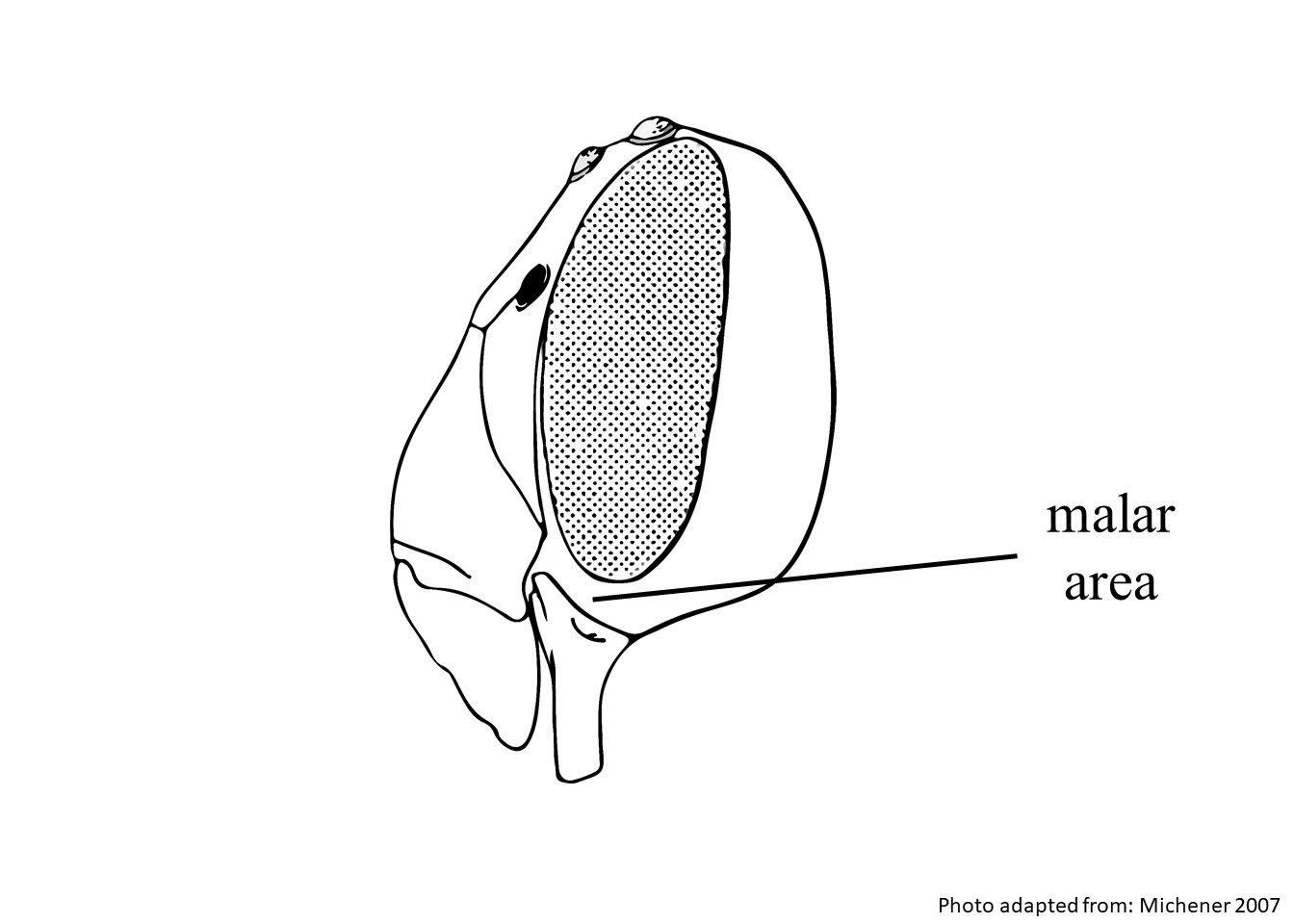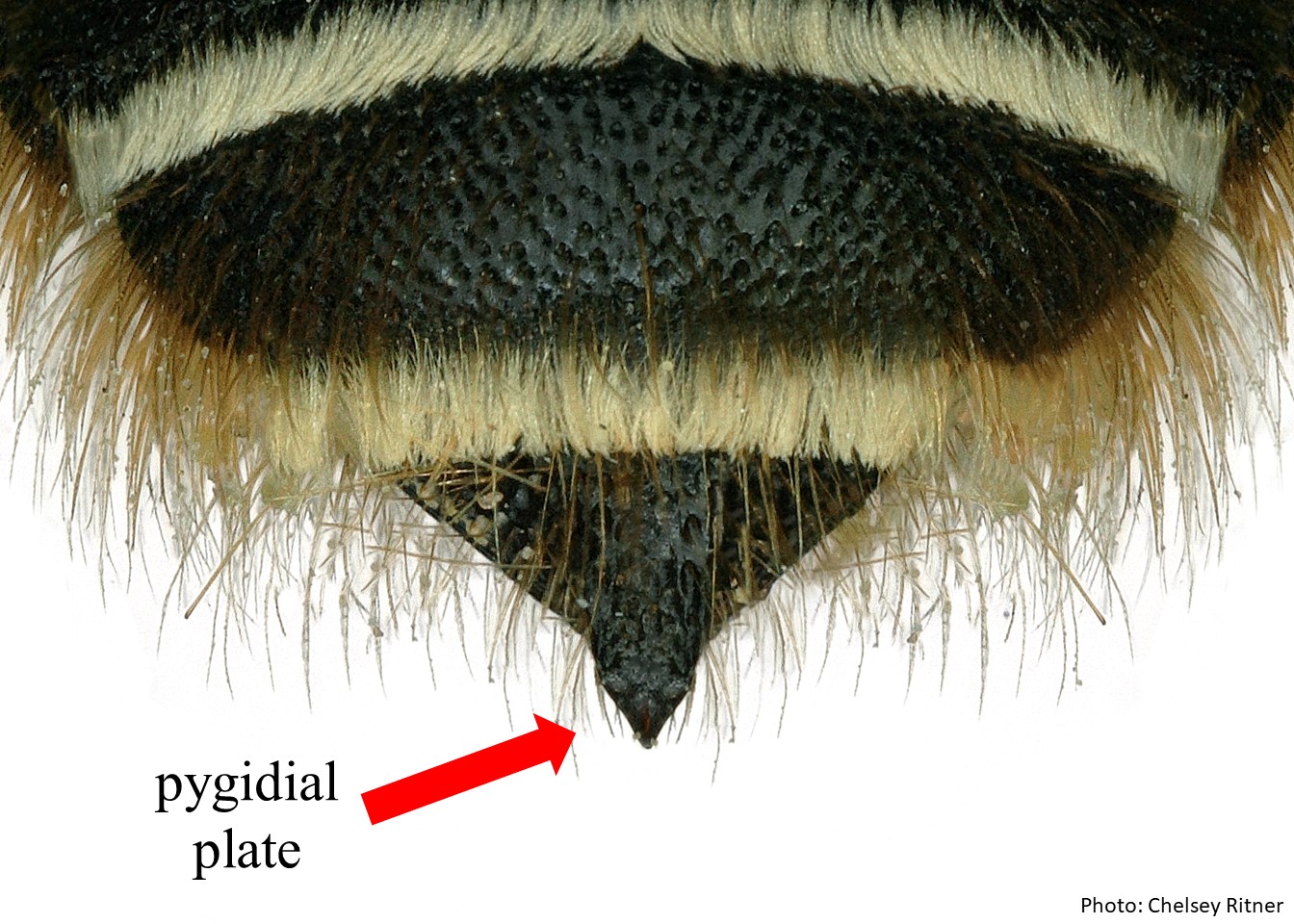Family: Apidae
Subfamily: Xylocopinae
Tribe: Xylocopini
Genus: Xylocopa
Subgenus: Xenoxylocopa, Hurd and Moure 1963Hurd and Moure 1963:
Hurd, P.D. and J.S. Moure. 1963. A Classification of the Large Carpenter Bees (Xylocopine) (Hymenoptera: Apoidea). University of California Publications in Entomology (Vol. 29). Berkeley and Los Angeles: University of California Press, 365 pp.
Common name: Carpenter bee
Males of Xylocopa (Xenoxylocopa) are medium to large sized bees, 16 – 30 mm in length, with dark brown to black integumentintegument:
a tough, protective outer layer
. They have primarily short, thick, dark brown to black pubescencepubescence:
short, fine hair
, sometimes with pale pubescencepubescence:
short, fine hair
on their sides and scutellumscutellum:
shield shaped plate behind scutum. Their wings are usually brown with weak iridescence (Hurd and Moure 1963Hurd and Moure 1963:
Hurd, P.D. and J.S. Moure. 1963. A Classification of the Large Carpenter Bees (Xylocopine) (Hymenoptera: Apoidea). University of California Publications in Entomology (Vol. 29). Berkeley and Los Angeles: University of California Press, 365 pp.).
Xylocopa (Xenoxylocopa) includes only one species, Xylocopa inconstans (Mawdsley 2017Mawdsley 2017:
Mawdsley, J. R. 2017. Taxonomy of the African large carpenter bees of the genus Xylocopa Latreille, 1802, subgenus Xenoxylocopa Hurd amp; Moure, 1963 ( Hymenoptera , Apidae ). Zookeys (655): 131-139.).
Xylocopa (Xenoxylocopa) is known throughout sub-Saharan Africa ranging from Senegal to Ethiopia and south to South Africa (Michener 2007Michener 2007:
Michener, C.D. 2007. The Bees of the World (2nd ed.). Johns Hopkins University Press, Baltimore and London, 953 pp.).

Distribution map generated by Discover Life -- click on map for details, credits, and terms of use.
Xylocopa (Xenoxylocopa) are generalist pollinators and have been observed visiting the flowers of a number of plant families including Acanthaceae Asphodelaceae, Bignoniaceae, Burseraceae, Cleomaceae, Combretaceae, Fabaceae, Nyctaginaceae, and Solanaceae (Eardley and Coetzer 2016Eardley and Coetzer 2016:
Eardley C. and W. Coetzer. 2016. Xylocopa sicheli Vachal, 1898, Catalogue of Afrotropical Bees. Version 1.6. Agricultural Research Council. https://doi.org/10.15468/u9ezbh.).
(modified from Hurd and Moure 1963Hurd and Moure 1963:
Hurd, P.D. and J.S. Moure. 1963. A Classification of the Large Carpenter Bees (Xylocopine) (Hymenoptera: Apoidea). University of California Publications in Entomology (Vol. 29). Berkeley and Los Angeles: University of California Press, 365 pp. and Minckley 1998Minckley 1998:
Minckley, R. L. 1998. A Cladistic Analysis and Classification of the Subgenera and Genera of the Large Carpenter Bees, Tribe Xylocopini (Hymenoptera: Apidae). Natural History Museum, The University of Kansas 9: 1-47.)
 short.
short. narrow, parallel-sided, and with subapicalsubapical:
narrow, parallel-sided, and with subapicalsubapical:Xylocopa (Xenoxylocopa) are most similar to X. (Koptortosoma) and X. (Mesotrichia) in the sharp transition between the dorsaldorsal:
in general, the upper surface
and anterioranterior:
toward the head or on the head side of a segment being described
surfaces of T1T1:
the segments on the top side of the abdomen, often abbreviated when referring to a specific segment to T1, T2, T3, T4, T5, T6, or T7 . X. (Xenoxylocopa) can be distinguished by the scutellumscutellum:
. X. (Xenoxylocopa) can be distinguished by the scutellumscutellum:
shield shaped plate behind scutum, which is convexconvex:
curved outward
and not angulateangulate:
forming an angle rather than a curve
. Females can also be distinguished by the pygidial platepygidial plate:
unusually flat area (a plate) surrounded by a ridge or line and sometimes sticking well off of the end of the bee; if present, found on the sixth upper abdominal segment in females, seventh in males with subapicalsubapical:
with subapicalsubapical:
located just behind the apex of the segment or body part
laterallateral:
relating, pertaining, or attached to the side
spines (Minckley 1998Minckley 1998:
Minckley, R. L. 1998. A Cladistic Analysis and Classification of the Subgenera and Genera of the Large Carpenter Bees, Tribe Xylocopini (Hymenoptera: Apidae). Natural History Museum, The University of Kansas 9: 1-47.).
Xylocopa (Xenoxylocopa) is known to nest in decayed twigs and branches as well as Aloe and Agave stems on occasion (Watmough 1974Watmough 1974:
Watmough, R.H. 1974. Biology and behaviour of Carpenter bees in southern Africa. Journal of the Entomological Society of Southern Africa. 37(2): 261-281.).
There are no known invasives.
Eardley, C., W. Coetzer. 2016. Catalogue of Afrotropical Bees. Version 1.6. Agricultural Research Council. https://doi.org/10.15468/u9ezbh.
Hurd, P.D. and J.S. Moure. 1963. A Classification of the Large Carpenter Bees (Xylocopine) (Hymenoptera: Apoidea). University of California Publications in Entomology (Vol. 29). Berkeley and Los Angeles: University of California Press, 365 pp.
Mawdsley, J.R. 2017. Taxonomy of the African large carpenter bees of the genus Xylocopa Latreille, 1802, subgenus Xenoxylocopa Hurd & Moure, 1963 (Hymenoptera, Apidae). Zookeys 655: 131-139.
Michener, C.D. 2007. The Bees of the World (2nd ed.). Johns Hopkins University Press, Baltimore and London, 953 pp.
Watmough, R.H. 1974. Biology and behaviour of Carpenter bees in southern Africa. Journal of the Entomological Society of Southern Africa. 37(2): 261-281.